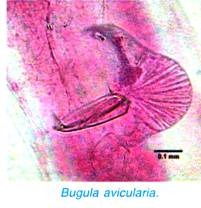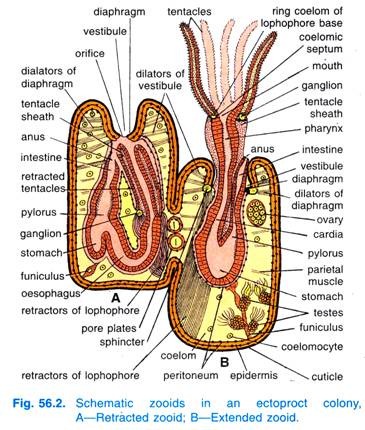In this article we will discuss about Ectoprocta:- 1. Meaning of Ectoprocta 2. Habit, Habitat and External Structure of Ectoprocta 3. Body Wall 4. Coelom 5. Digestive System 6. Circulatory, Excretory and Nervous System 7. Reproductive System 8. Development 9. Affinities.
Contents:
- Meaning of Ectoprocta
- Habit, Habitat and External Structure of Ectoprocta
- Body Wall of Ectoprocta
- Coelom of Ectoprocta
- Digestive System of Ectoprocta
- Circulatory, Excretory and Nervous System of Ectoprocta
- Reproductive System of Ectoprocta
- Development of Ectoprocta
- Affinities of Ectoprocta
1. Meaning of Ectoprocta:
Ectoprocta are microscopic, sessile, colonial, un-segmented coelomate animals that are fastened, permanently in exoskeletal cases or gelatinous material of their own secretion with a circumoral ring, crescentic lophophore and a U-shaped digestive tract bringing the anus near the mouth but without nephridia and circulatory system.
The Ectoprocta form colonies known as “Sea-mats” or “Corallines” which in many cases bear a general resemblance to hydroid coelenterates. The ectoprocts exhibit slight structural diversities and a typical genus Bugula has been described here as an example of Ectoprocta.
2. Habit, Habitat and External Structure of Ectoprocta:
Bugula avicularia, the common Bird’s Head Coralline occurs in brown or purple bushy tufts, 5.0 to 7.0 cm long, found attached on rocks, piles of jetties and similar situations on the shore in all the parts of the world. The ectoprocts are strictly benthonic and pelagic only in larval stages. Bugula is a ciliary feeder and lives on micro-organisms, specially the diatoms.
External Structures of Ectoprocta:
An ectoproct colony superficially resembles to a hydroid coelenterate but a closer examination reveals that it has a much higher type of organisation. A complete ectoproct colony is called zoarium. It is composed of several individuals or units called zooids.
The colony of Bugula consists of dichotomously branched narrow stem, which are rooted by a number of slender root filaments. Each stem is composed of a. number of elements, the zooecia of the colony, which are closely united together and arranged in four longitudinal rows.
The zooecia are cylindrical in shape, but broader distally than proximally, five times as long as broad and have, near the distal end, a wide crescentic aperture, the mouth of the zooecium, on either of which is a short blunt spine. A rounded structure the ooecium, in many parts of the colony lies in front of each zooecium.
On each zooecium except a few, is a remarkable appendage, the avicularium. The avicularium has appearance of bird’s head supported on a very short stalk.
The chitinous wall of the zooecia is the hardened and thickened cuticle of zooids, having beneath it the soft body wall. The anterior region of the body of the zooid forms an introvert. When the introvert is everted it is seen to bear at its anterior end a circlet of usually fourteen long, slender, filiform tentacles on a circular ridge or lophophore surrounding the mouth of the zooid.
The tentacles are densely ciliated except along their outer surfaces. The cilia of the tentacles vibrate in such a way as to drive currents of water and with them food particles towards the mouth.
The tentacles are capable of being bent in various directions. In the interior of each tentacle is a narrow prolongation of the coelom. Besides bringing minute food particles to the mouth of the zooid by the action of their cilia, the tentacles are tactile and also act as organs of respiration.
When retracted they become enclosed by the walls of the introvert or by a sheath, the tentacle sheath. A pair of bands of muscle fibres, the parietovaginal muscles passing to the introvert from the body wall serve to retract the introvert tentacles. The main body of the zooid is the trunk which is immovably attached inside the zooecium. It contains the coelom and other internal organs.
3. Body Wall of Ectoprocta:
The body wall consists of cuticle, epidermis, two muscular layers and parenchyma.
The cuticle forms the covering of the zooecium. Beneath the cuticle lies the epidermis composed of a single layer of large flattened cells. Muscle layers are present in some genera, while absent in others. When present there are two layers, the outer circular and inner longitudinal. The innermost layer is of peritoneal cells in some cases or of irregular cellular tissue or parenchyma.
4. Coelom of Ectoprocta:
The coelom is quite extensive and is incompletely divided into two parts by an incomplete septum. The anterior coelom is small and called the ring coelom.
The ring coelom is situated at the base of the lophophore and extends into the tentacles. The trunk coelom is quite large and occupies the space between the body wall and the alimentary canal. The trunk coelom is traversed by 20-40 pairs of muscle fibres which are regarded as the displaced muscles of the body wall.
A large double strand passes from the proximal or aboral end of the alimentary canal to the aboral wall of the zooecium, is the funiculus.
The coelom is lined externally either by the parietal layer of parenchyma or ciliated peritoneum and internally by visceral layer of the same tissue, en-sheathing the alimentary canal. Coelom is crossed by numerous radiating strands of spindle- shaped cells. The coelom is filled with a colourless fluid containing several kinds of suspended coelomocytes.
5. Digestive System of Ectoprocta:
The alimentary canal is a U-shaped tube. The mouth is situated at the centre of the lophophore. The mouth leads into a wide chamber the pharynx which passes into the oesophagus. The oesophagus leads into stomach. The stomach gives off a long conical prolongation or caecum passing towards the aboral end of zooecium to which it is attached by the funiculus.
The intestine comes off from the oral aspect of the stomach. The intestine terminates in a rounded anus situated near the mouth but outside the lophophore. The entire alimentary canal is lined by an epithelium which is ciliated throughout except in a portion of the stomach. A pair of slender muscles passing from the body wall to the stomach act as retractors of the alimentary canal when the introvert is drawn back.
6. Circulatory, Excretory and Nervous System of Ectoprocta:
There are no blood vessels in the ectoprocts and the circulatory system is entirely absent.
Excretory System of Phylum Ectoprocta:
Definite excretory organs do not occur in ectoprocts. The function of excretion (i.e., the collection of nitrogenous waste matters) being apparently carried on by the leucocytes and the cells of the funicular tissue.
Nervous System of Phylum Ectoprocta:
The nervous system consists of a small round ganglion situated in the ring coelom between the mouth and anus. This ganglion gives off nerves to various parts of the body. The ganglion is continuous with the nerve ring surrounding the pharynx. The nerve ring gives two ganglionated motor and sensory nerve fibres to each tentacle. Special organs of sense are absent.
7. Reproductive System of Ectoprocta:
Bugula is hermaphrodite. Ovary and testis are found to occur together in the same zooid. Both ovary and testis are formed from specially modified cells of the parenchyma, either of the funiculus or of the body wall. The testis develops from the cells of the funicular tissue and gives origin to the spherical masses of cells, the spermatidia which develop into sperms with very long motile tails.
These become free from one another and move about in the body cavity or in its prolongations into tentacles. There is no sperm duct and it is doubtful if the sperms pass to the exterior. The ovary is a small rounded body formed from the parietal layer of the parenchyma about the middle of the zooecium.
It consists of only a small number of cells of which only one at a time becomes a mature ovum, certain smaller cells forming an enclosing follicle. The mature ovum is perhaps fertilised in the coelom. It passes into the interior of a rounded outgrowth of the zooecium, the ooecium lined with parenchyma and forming a sort of brood pouch in which it undergoes development.
Ectoprocta reproduce asexually by budding statoblasts, hybernacula, brown bodies and regeneration.
8. Development of Ectoprocta:
Self-fertilisation has been observed in Bugula. The fertilised egg undergoes cleavage which is holoblastic (complete) and nearly regular. The plane of cleavage is of radial type. A coeloblastula is formed which eventually transforms into a gastrula by the process of delamination. During the process of production of 64-128 blastomeres, four elongated cells become cut off into the blastocoel.
These are actually endomesodermal cells which give endoderm and mesenchyme. The larva is called cyphonautes. The cyphonautes larva in Bugula shows few specialised features, viz., oval shape, absence of alimentary canal and delimitation of the apical organ by a circular groove.
9. Affinities of Phylum Ectoprocta:
The phylogenetic relationships of Ectoprocta are uncertain and controversial. The controversy is due to their structural similarities with other groups of animals.
Affinities with Phoronida:
Caldwell (1888) emphasised the affinities between Ectoprocta and Phoronida.
This idea was based on the following similarities:
(1) Both are provided with horse-shoe-shaped lophophore.
(2) Presence of epistome.
(3) U-shaped alimentary canal.
(4) Similar disposition of the coelom and the presence of a septum separating the mesocoel and metacoel.
(5) The nerve centre is located in the mesocoel and is supraenteric. But the detailed study of the two groups exhibited many structural differences between them. They differ widely in their anatomical organisation. The embryology also exhibits many differences.
The noteworthy differences are as follows:
(1) The origin of coelom is different.
(2) The region between the mouth and anus is dorsal in position in Phoronida and ventral in Ectoprocta.
(3) The circulatory system and nephridia are absent in Ectoprocta, while in Phoronida both the systems are present. Due to the above-mentioned differences the affinities between Ectoprocta and Phoronida cannot be established.
Affinities with Brachiopoda:
There are many similarities between Ectoprocta and Brachiopoda.
These similarities are:
(1) Both have similar body organisation.
(2) Bivalved shell of cyphonautes larva of Ectoprocta can be compared to the shell of Brachiopoda.
(3) Presence of coelomic septum between the mesocoel and metacoel.
(4) Alimentary canal is U-shaped. Besides the above similarities, there are many structural differences between these two groups.
The main differences are as follows:
(1) The brachiopod shell cannot be compared to the exoskeleton of Ectoprocta.
(2) In Brachiopoda the shell is dorso-ventrally placed, while in ectoproct larva the shell is laterally placed.
(3) The chitinous setae present in Brachiopoda are absent in Ectoprocta.
(4) The nervous system is mainly supraenteric in Ectoprocta, while in Brachiopoda it is subenteric. Because of lack of specific relationships between them, the affinities between these two groups cannot be established.
Affinities with Endoprocta:
Previously Ectoprocta and Endoprocta were linked together as two classes under the phylum Bryozoa or Polyzoa because of the following similarities:
(1) Presence of a crown of ciliated tentacles.
(2) Presence of looped alimentary canal.
(3) Similarity in larval stages. But such features occur in common in all the sessile animals. A careful examination of the structural organisation reveals that these two groups are fundamentally different from each other.
They exhibit many differences. The main differences are as follows:
(1) The tentacular crown surrounds only the mouth in Ectoprocta, but in Endoprocta both the mouth and anus are enclosed by the tentacles.
(2) The Ectoprocta possess true coelom, whereas in Endoprocta the true coelom is absent.
(3) The nephridia and gonoducts are absent in Ectoprocta, while in Endoprocta both of them are present. Considering these features it is quite apparent that Ectoprocta is highly organised than the Endoprocta.
From all the information of anatomy and embryology available for Ectoprocta, it is convenient to place the ectoprocta under a separate phylum having phylogenetic relationship with the two other lophophorate coelomates, i.e., Phoronida and Brachiopoda.


